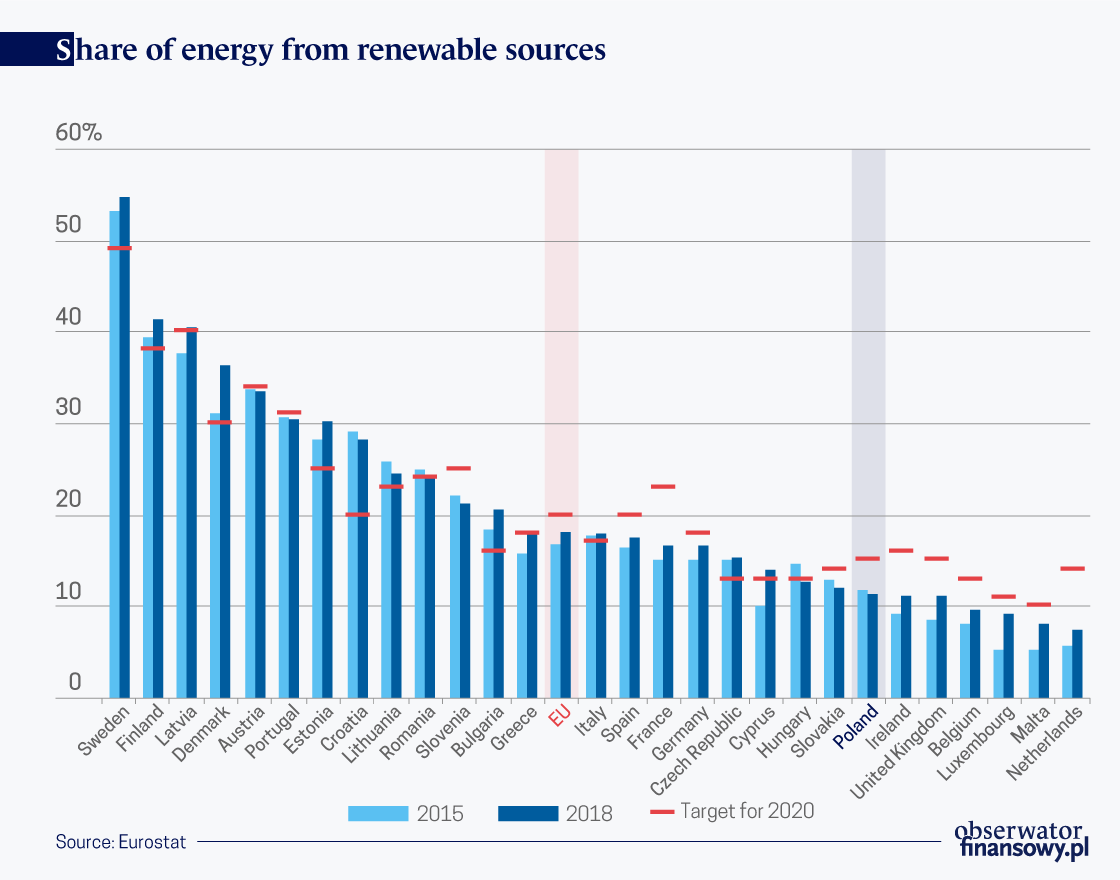
The share of renewable sources in the total energy consumption is steadily rising in EU countries. In 2018 – as the Eurostat summary shows — the share of RES in energy consumption increased from 17.5 per cent to 18.0 per cent compared to 2017. Only 2.0 percentage points remained to meet the target (20 per cent in 2020). However, it can be assumed that with the adoption of the New Green Deal rules in the European Union, which is to neutralize the level of greenhouse gas emissions on the European continent, the importance of RES will grow rapidly in the coming years. The use of energy from renewable sources leads most often (maybe except biomass burning) to the simultaneous reduction of CO2 emissions.
In 2018, the majority of EU Member States improved their performance. The exceptions, i.e. countries where the share of RES decreased between 2017 and 2018, included Italy and Lithuania but both countries had already met their individually adopted targets related to the share of energy from renewable sources. In the case of Lithuania this share is to reach 23 per cent. This is not the case in Hungary, where the share of RES in the total energy consumption has been systematically decreasing since 2015. In 2017, Hungary still met the 13 per cent target set for the current year, which was not very high; however, a year later the country already left the path leading to its achievement.
Among the EU countries, the highest share of renewable sources in the total energy consumption is achieved by Sweden, where in 2018 it already reached 54.6 per cent, well above the individually adopted level of 49 per cent. In this respect, Sweden is only preceded by the neighboring Norway, which is not a member of the EU, where the share of RES in energy consumption is already approaching three-quarters. Among the European countries, Norway is closest to the “energy perpetuum mobile” model today.
EU leaders of economic development based largely on the use of renewable energy sources include Finland (41.2 per cent in 2018), Latvia (40.3 per cent) and Austria (33.4 per cent). Renewable sources are also significant for the economies of two non-EU countries — Montenegro and Albania. In both these Western Balkan countries the share of RES is more than one third.
In terms of the use of renewable energy sources, Poland is significantly outperformed by most of the European Union Member States, although there are EU countries where this share is even lower, such as Ireland, Belgium or the Netherlands. In 2018, this share amounted to 11.3 per cent, well below the target of 15.0 per cent adopted for 2020, lower than for the entire EU. However, it is comforting that in 2018 the downward trend in the share of RES in Poland’s energy mix continuing for several years was reversed. Back in 2015, this share amounted to 11.7 per cent.
Renewable sources are most important in electricity production. At the European Union level (28 countries, including the United Kingdom), almost one third of electricity, i.e. 32.1 per cent, originates from renewable sources. More detailed Eurostat data shows that wind energy moved to the top of the list in 2018. In 2018, wind turbines supplied nearly 32.4 mtoe, i.e. million tons of oil equivalent. 1 toe is the equivalent of one metric ton of crude oil with a calorific value of 10,000 kcal/kg, which corresponds to 11.63 megawatt hours of energy – for those used to old measurement units. In 2018, hydroelectric power plants, which provided less than 30.1 mtoe, fell to the second place in terms of their importance. Electricity from solar sources is still less important (11.0 mtoe in 2018).
In Poland, in 2018, electricity production from renewable sources amounted to 1963.7 ktoe. The share of RES in electricity generation — 13.03 per cent in 2018 — is much lower compared to the EU. Since 2015, windmills have been gaining an increasing advantage over other sources (hydroelectric power plants, biogas). In 2018, nearly 60 per cent of electricity from RES originated from wind power. In statistical terms, electricity from solar installations is of marginal importance for now (25.8 ktoe in 2018), however, the growth rate in this area exceeded 80 per cent.
Both in Poland and in the EU, RES are the most important in electricity production. In the case of Poland, however, the improvement of their overall share in the total energy consumption (from 10.96 per cent in 2017 to 11.28 per cent in 2018) has primarily resulted from changes in transport. In 2018, the consumption of energy from renewable sources in Poland increased from 687.3 ktoe in 2017 to 1000.7 ktoe in 2018.


